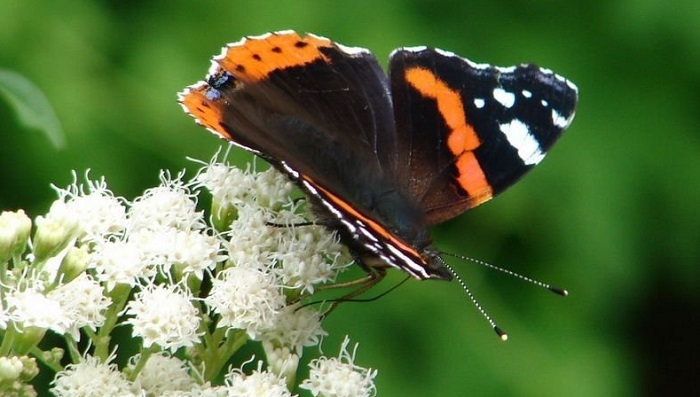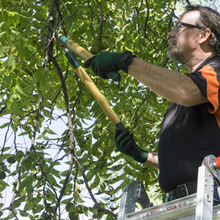These settlers brought along the basic necessities to help them build a new life in the west, along with their livestock. Cows were treasured, both as a source of meat and of milk, and it is particularly tragic that they were the indirect transmitters of an affliction the settlers had not encountered before: milk sickness.
In 1816, Mr. Thomas Lincoln and his wife, Nancy Hanks Lincoln, left their home in Kentucky for a new frontier in the wilderness of southern Indiana. Their children, Sarah and Abraham, were about 11 and 9 years old respectively when they built their first cabin in an area known as Little Pigeon Creek settlement, in the far southern end of Indiana. I can imagine how they must have helped their parents with the hard work of clearing the land and building the cabin. The foundations and fireplace of that cabin are still existent today, at a memorial built at the site.

Clearing the trees enough to build a home and plant a meager first crop was usually the first priority. Livestock was often allowed to roam and forage in the woods, and then collected at nightfall to be shut up safely away from the wild animals that roamed in the dark. Few settlers knew that growing among the woods and thickets of those midwestern states grew an innocuous looking wildflower called white snakeroot. Their ignorance of the native plants of the midwest led to the tragic deaths of literally thousands of settlers, of an illness called "milk sickness," or "the trembles."
The plant in question, known by the common name White Snakeroot, was initially categorized by botanists as Eupatorium rugosum, though it is now instead categorized as Ageratina altissima. White Snakeroot is a herbaceous perennial that gets its name from the root decoction made by American Indians as a cure for snakebite. The Cherokees have used it as an anti-diarrheal, kidney stone and urinary disease medicine. [1]
The University of Illinois gives the following detailed description of the plant, in its veterinary catalogue of toxic plants [2]:
"White snakeroot is an erect, branched herb usually about 3 feet tall but varying from 1 to 5 feet. It has slender, round stems and branches bearing pointed, oval, oppositely placed leaves. These leaves, 3 to 5 inches long and petioled, are sharply toothed on the margins. Each leaf has 3 main veins that show prominently on the underside. The roots are fibrous, coarse, and shallow.
In late summer, numerous small heads of minute white flowers appear at the top of the stem and the ends of the branches. These flower heads, except that they are white, are almost exactly like the flower heads of the familiar ageratum of gardens. Later the flowers are replaced in the heads by small black seeds each with a crown of soft white hairs.
Because the leaves of white snakeroot resemble those of the nettle, other plants with nettle-like leaves are often mistaken for it. Two such plants are the nettle-leaved sage and the nettle-leaved vervain. Even without flowers or fruit, these plants can be easily distinguished from white snakeroot. The nettle-leaved sage, a rare plant in some southern Illinois counties, has square stems; white snakeroot stems are round. The nettle-leaved vervain, a common weed throughout Illinois, has lance-shaped leaves; white snakeroot leaves are broad at the base but narrow quickly in a wedge-shaped part to the petiole."
Nancy Lincoln, along with her aunt and uncle, Elizabeth and Thomas Sparrow, are assumed to be among the many victims of milk sickness at Little Pigeon Creek Settlement in Indiana. At the time, of course, no one knew what an interest everyone would take in every detail of Abraham Lincoln's early life. No one recorded the symptoms or means of death of Nancy Lincoln, though almost all sources attribute it to "milk sickness." What IS recorded is that Thomas built the pine coffin for his young wife, only 34 years of age at her death on October 5, 1818, and Abraham Lincoln later wrote of helping to whittle the pegs to hold together the planks for his mother's coffin. Her family buried her near a neighbor, Nancy Rusher Brooner, whom Nancy Hanks Lincoln had been nursing through the ravages of milk sickness a few weeks prior to her own deadly bout of it.
Milk sickness was a mystery to the settlers. They were familiar with the diseases common on the east coast, such as small pox, malaria, dysentery, cholera, typhoid fever, and pneumonia. They brought many of them west with them, to the dismay of the native populations. Poor nutrition and malnourishment often accompanied these travelers, as they barely eked out their existence in new homesteads. They depended heavily on their livestock to provide milk, from which they would make homemade cheese and butter, and meat to sustain them in the absence of a more varied and balanced diet.
This new disease, however, struck animals and humans alike, and was a great source of fear for the settlers, who had no idea how it was transmitted. The animals, including sheep, goats, horses, and cows, were often the first to show symptoms, which included tremors, and the curious habit in horses and cattle of standing with their hind feet very close together. Other symptoms in animals include lethargy, nasal discharge, excessive salivation, arched body posture, and rapid or difficult breathing. [3] Adult cattle seemed the least affected, and sometimes didn't even show any symptoms of poisoning, though any calves that were nursing from stricken animals usually died.
Soon after, people who drank the milk or ate meat from the affected animals would begin to experience drastic symptoms, as well. The symptoms started much like other digestive complaints, with loss of appetite, vomiting, gastrointestinal pain, and constipation. I suspect castor oil, a common cure-all for digestive complaints, was frequently employed, but the affected individuals did not improve. The disease progressed to include muscle pain, and eventually the sufferer would fall into a coma and die. Some sources attribute more than half of the deaths that occurred early in the 19th century in Dubois County, Indiana, to milk sickness. [4] It is hard to comprehend, in our modern day and age, the terror and grief that this widespread ailment must have caused, when they were ignorant of the cause or any treatment to alleviate the symptoms.
After the death of Nancy Lincoln, Thomas remarried in 1819, to a widow he'd known back in Kentucky, Sarah Bush Johnston. In 1830, he moved his family to Illinois on the advice of Nancy's cousin, John Hanks, who reported that the soil was fertile and the area free of the horrible milk sickness that had taken so many lives in southern Indiana. It was many years before people understood that they had actually suffered a type of poisoning, called tremetol poisoning, rather than contracting a contagious illness.
Doctor Anna Pierce Hobbs Bixby is credited with making the connection in the 1830's between animals grazing on white snakeroot plant in uncultivated pastures, and the passing of the toxins through the milk to humans. Tradition has it that she learned of the association from an unknown Shawnee woman, whose people lived in the area and knew the native herbs and plants well. Unfortunately, news traveled slowly, and people continued to be afflicted with milk sickness for some time after the root cause was discovered. The weed still grows prolifically throughout the country, especially in the midwestern states of Ohio, Indiana, Illinois, Iowa. There are still reports of isolated outbreaks of tremetol poisoning, though it is much less common now that most cattle are grazed on cleared, maintained pasturelands, and the milk from many cows is combined, diluting the effect of any individual cows that may consume the weed.

Quotes:
[1]http://donnallong.com/2011/12/10/white-snakeroot-pretty-but-poisonous/
[2]http://www.library.illinois.edu/vex/toxic/snkroot/wksroot.htm
[3] http://en.wikipedia.org/wiki/Ageratina_altissima
[4]http://www.nps.gov/libo/historyculture/milk-sickness.htm
Additional Resources:
Daly, Walter J. "The Slows: The Torment of Milk Sickness on the Midwest Frontier" INDIANA MAGAZINE OF HISTORY, 102 (March 2006) 0 2006, Trustees of Indiana University
http://rogerjnorton.com/Lincoln81.html
http://en.wikipedia.org/wiki/Lincoln_Boyhood_National_Memorial
http://www.britannica.com/blogs/2009/10/dont-drink-the-milk-white-snakeroot-a-guide-to-poison-gardens-a-weekly-blog-series/
Photo Credits:
Snakeroot plant images courtesy of PlantFiles.
Foundations of Lincoln cabin in Indiana: Wikimedia Commons, in the public domain.

















